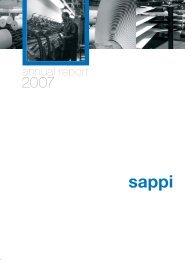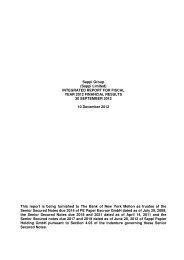SAPPI LTD (SAP) 6-K
SAPPI LTD (SAP) 6-K
SAPPI LTD (SAP) 6-K
You also want an ePaper? Increase the reach of your titles
YUMPU automatically turns print PDFs into web optimized ePapers that Google loves.
Property, plant and equipment<br />
Items of property, plant and equipment are measured at original cost. Property, plant and equipment is presented in the balance sheet at cost less accumulated<br />
depreciation and impairment losses. For investments in property, plant and equipment requiring a long construction time, the interest cost incurred during<br />
construction is capitalised in the combined balance sheet as part of the asset for the time that is necessary for bringing the asset to working condition for its<br />
intended use.<br />
Items of property, plant and equipment are depreciated on a straight-line basis over the following expected useful lives:<br />
Category<br />
Depreciation period<br />
Buildings<br />
20 to 40 years<br />
Property, plant and equipment 5 to 20 years<br />
Other property, plant and equipment5 to 20 years<br />
Other property, plant and equipment consist of bridges, dams, asphalt work and similar items.<br />
Land is not depreciated. If the significant parts of an item of property, plant and equipment have useful lives of differing length, each part is depreciated<br />
separately.<br />
The estimated useful lives and residual values are reassessed at each reporting date and adjusted if necessary. Expenditures arising from large-sized<br />
modernisation and improvement projects are capitalised in the balance sheet if it is probable that the economic benefit resulting from the projects will exceed<br />
the estimated revenue originally obtainable from the asset item that is to be modernised. Other expenditure related to repairs and maintenance is expensed in<br />
the period in which it is incurred.<br />
Gains and losses on disposal or retirement of tangible fixed assets are determined by comparing the proceeds received with the carrying amounts and are<br />
included in the combined income statements.<br />
Leases<br />
Leases on assets for which the Company assumes substantially all the risks and rewards incident to ownership of the asset are classified as finance lease<br />
agreements. A finance lease agreement is recognised in the balance sheet at an amount equal at the inception of the lease to the fair value of the leased<br />
property or, if lower, at the present value of the minimum lease payments. The corresponding lease payment liability is recorded in interest-bearing liabilities<br />
under other non-current liabilities. An asset obtained on a finance lease is depreciated over the useful life of the asset or, if shorter, the lease term. Lease<br />
payments are split between financial expenses and a reduction in the lease liabilities.<br />
Lease agreements in which the risks and rewards incident to ownership remain with the lessor are treated as other lease agreements (operating leases). Lease<br />
payments under an operating lease are recognised as an expense in the income statement on a straight-line basis over the lease term.<br />
Goodwill<br />
Goodwill represents the excess of the acquisition costs over the fair value of the net assets acquired, at the date of acquisition. Under the exemption provided<br />
by IFRS 1 First-time Adoption of International Financial Reporting Standards, M-real elected not to apply IFRS 3 Business Combinations retrospectively to<br />
business combinations made prior to 1 January 2004, the date M-real transitioned to IFRS. Accordingly, goodwill resulting from business combinations prior<br />
to M-real’s transition to IFRS has been measured in accordance with Generally Accepted Accounting Standards in Finland (“Finnish GAAP”) and has not<br />
been adjusted retroactively.<br />
68
















